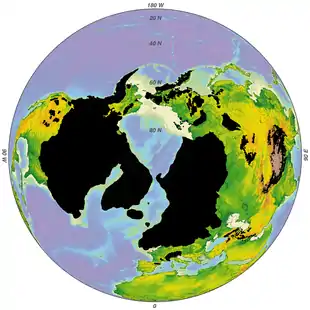Mesoarchean
The Mesoarchean (/ˌmiːzoʊɑːrˈkiːən/, also spelled Mesoarchaean) is a geologic era within the Archean Eon, spanning 3,200 to 2,800 million years ago. The era is defined chronometrically and is not referenced to a specific level in a rock section on Earth. Fossils from Australia show that stromatolites have grown on Earth since the Mesoarchean.[1][2] The Pongola glaciation occurred around 2,900 million years ago.[3] The first supercontinent Vaalbara broke up during this era about 2,800 million years ago.
| Mesoarchean | |
|---|---|
| 3200 – 2800 Ma | |
| Chronology | |
-4500 — – -4000 — – -3500 — – -3000 — – -2500 — – -2000 — – -1500 — – -1000 — – -500 — – 0 — | |
| Proposed redefinition(s) | 3490–2780 Ma Gradstein et al., 2012 |
| Proposed subdivisions | Vaalbaran Period, 3490–3020 Ma Gradstein et al., 2012 |
| Etymology | |
| Name formality | Formal |
| Alternate spelling(s) | Mesoarchaean |
| Usage Information | |
| Celestial body | Earth |
| Regional Usage | Global (ICS) |
| Time scale(s) used | ICS Time Scale |
| Definition | |
| Chronological unit | Era |
| Stratigraphic unit | Erathem |
| Time span formality | Formal |
| Lower boundary definition | Defined Chronometrically |
| Lower boundary GSSP | N/A |
| GSSP ratified | N/A |
| Upper boundary definition | Defined Chronometrically |
| Upper boundary GSSP | N/A |
| GSSP ratified | N/A |
The earliest reefs date from this era, and were probably formed by stromatolites.[1][2] Analysis of oxygen isotopes in cherts led to an oceanic temperature estimate around 55-85 ºC,[4] while other studies of weathering rates postulate average temperatures below 50 ºC.[5] Dinitrogen content in the atmosphere is thought to have been fundamentally similar to today's, and the partial pressure of carbon dioxide was probably lower than 0.7 bar.[6]
See also
- Geologic time scale – system that relates geological strata to time
- Glacial period – Interval of time within an ice age that is marked by colder temperatures and glacier advances
- Ice age – Period of long-term reduction in temperature of Earth's surface and atmosphere
- Last glacial period
References
- Allwood, Abigail C.; Walter, Malcolm R.; Kamber, Balz S.; Marshall, Craig P.; Burch, Ian W. (8 June 2006). "Stromatolite reef from the Early Archaean era of Australia". Nature. 441 (7094): 714–718. Bibcode:2006Natur.441..714A. doi:10.1038/nature04764. PMID 16760969.
- Nelson, Jon (15 April 1997). "Stromatolites: Our Mysterious Ancient Reefs". Lake Superior Magazine. Archived from the original on 18 February 2019. Retrieved 10 March 2018.
- Robert E. Kopp; Joseph L. Kirschvink; Isaac A. Hilburn & Cody Z. Nash (2005). "The Paleoproterozoic snowball Earth: A climate disaster triggered by the evolution of oxygenic photosynthesis". Proc. Natl. Acad. Sci. U.S.A. 102 (32): 11131–6. Bibcode:2005PNAS..10211131K. PMC 1183582. PMID 16061801. Retrieved 2011-06-19.
- Knauth, L. P. Lowe, D. R. High Archean climatic temperature inferred from oxygen isotope geochemistry of cherts in the 3.5 Ga Swaziland group, South Africa, Geol. Soc. Amer. Bull. 115 (2003) 566 – 580.
- Sleep, Norman H.; Hessler, Angela M. (January 2006). "Weathering of quartz as an Archean climatic indicator" (PDF). Earth and Planetary Science Letters. 241 (3–4): 594–602. Bibcode:2006E&PSL.241..594S. doi:10.1016/j.epsl.2005.11.020. Archived (PDF) from the original on 10 March 2018. Retrieved 10 March 2018.
- Marty, Bernard; Zimmermann, Laurent; Pujol, Magali; Burgess, Ray; Philippot, Pascal (4 October 2013). "Nitrogen Isotopic Composition and Density of the Archean Atmosphere". Science. 342 (6154): 101–104. arXiv:1405.6337. Bibcode:2013Sci...342..101M. doi:10.1126/science.1240971. ISSN 0036-8075. PMID 24051244.
External links
| Wikimedia Commons has media related to Mesoarchean. |
